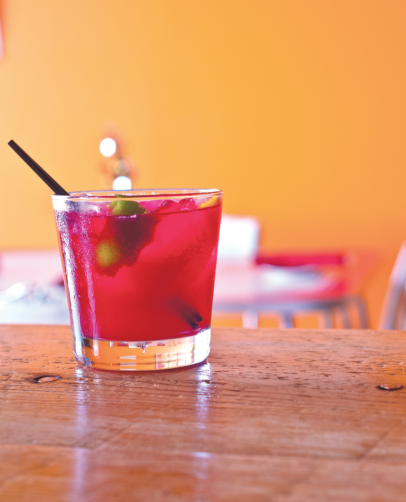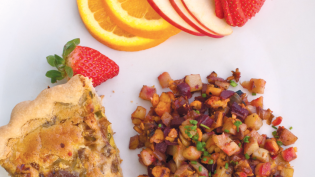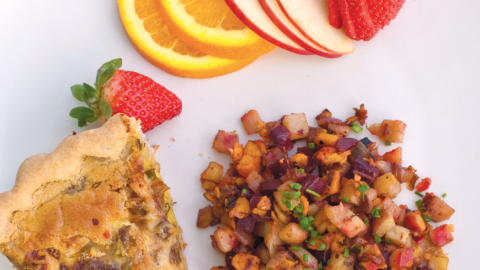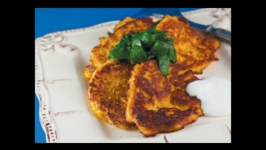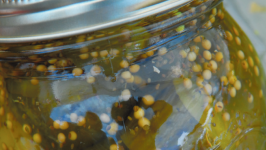Beets: Healthy and Hip
Time was when a love of beets went hand-in-hand with gray hair and senior citizen discounts. Your grandmother ate beets. Cold, pickled discs that spilled from a jar and eyed you from the plate, surrounded by a puddle of bland burgundy liquid.
Beets were the least popular kids in vegetable class, always picked last. They were a dull purple period at the end of the sentence "I am now old."
But lately, beets' fortunes have changed, marked by the ubiquity of roasted beet-and-goat cheese salads on menus across the land. A recent story in the Chicago Tribune reported that, according to food industry research firm Technomic, the number of beet dishes on restaurant menus increased by 16 percent between 2009 and 2010. And beets don't seem to be slowing down.
Ugly ducklings no longer, beets today stands as a bright, scarlet exclamation point at the end of the sentence "I am healthy and hip!"
In North Carolina, chefs are turning them into sushi and cake, squeezing them to extract their myriad nutritional benefits, and using them to transform cocktails into unforgettable crimson potions of delight. Yet, it can be tough to figure out what to do with beets at home. They arrive, grimy and bumpy, their green tops flailing about in the CSA box. And they always seem to be there, for all but a few months of the year. The beet is a hearty survivor of both the elements and the whims of food fashion.
Among the vegetable's newest devotees is Amir Sadeghi, a 2012 graduate of East Carolina University and the owner of a downtown Raleigh juice shop called Cold Off The Press.
"It probably was when I started learning about them that I started loving them," he said.
Cold off the Press isn't a smoothie bar. There's not a Vitamix blender in sight. Sadeghi and his partners make their juices off-site using nothing but fruits and vegetables, which they pulverize and cold press using two tons of pressure. One of their most popular juice varieties is Feel the Beet, a blend of beetroots, celery, carrot, apple, lemon and ginger. Each 17-ounce bottle contains the juice of one half-pound of beets, all grown within 100 miles of the store.
Feel the Beet is sweet but complex. The earthiness of the beets hits your nose when you twist open the top, like the scent of the garden in early spring. The taste is at once vegetal and sugary, followed by notes of apple, lemon and the barest hint of ginger.
Sadeghi, who holds a degree in exercise physiology, has found research indicating that beet juice fights high blood pressure and aids detoxification. Beets have also been found to aid liver function and even boost moods, through the biosynthesis of hormones and neurotransmitters such as dopamine and seratonin.
While Sadeghi loves beets, they are the least favorite of the raw ingredients that he and his partners must deal with.
"It takes a lot of scrubbing because beets are the dirtiest vegetable out there," he said.
The thing about beets is that they make a God-awful mess. The earth is so embedded in their thick skins that scrubbing them clean inevitably results in mud spattered all over the place. A good long soak in a sink of cold water helps, but regardless, cleaning a beet will get you dirty.
Caroline Morrison, chef and owner of Fiction Kitchen, uses beets in an array of unexpected ways. Her advice for infiltrating their hides to find their sweet hearts: Cut the ends off and boil them in water until they're just done.
"Then the skins just come right off," she said.
Hipsters and foodies pack Morrison's all-vegetarian, locally sourced restaurant on the edge of Raleigh's warehouse district. They come for a range of specialties, including housemade root vegetable chips, colored with beet juice, and nori rolls packed with cucumbers, beets, vegan cream cheese and spicy chutney. On occasion, they'll find a cake made with beets, in the mode of carrot cake, slathered in vegan cream cheese frosting. And Sunday brunch means root vegetable hash, toothsome mélange of onions, potatoes, and beets.
Morrison values beets for their versatility. Home cooks should experiment with them.
"I would say they could be a substitute for anything that has root vegetables in it," she said.
Any effort expended is rewarded ten-fold. Among the beet's many alluring qualities is that while it is good for you, it is not self-righteous. It does not stand in judgment as the parsnip or the turnip seems to. Beets have a dark side, a mysteriousness that makes you wonder what sort of mischief they could get up to.
It's this quality that makes the Beet Jammer, a cocktail of roasted beet-infused vodka, apple cider and Blenheim's spicy gingerale served at J. Betski's, such an enchanting concoction. The vodka's association with the beets turns it a beautiful color and gives it a deep, rustic sweetness. Combined with the apple cider and the spicy pep of the gingerale, it exceeds the sum of its parts to be oddly unforgettable. It has won fans far and wide, even among those who profess to hating beets.
That inaugural sip of a Beet Jammer can be much like peeling a beet for the first time. You know you're in for something different, but the experience can still prove unsettling. The beet's dull purple exterior yields suddenly to brilliant stripes of ruby and garnet, and the dark pink juice stains everything it drips on. The interior of the vegetable is so strikingly red, you feel a bit like an alchemist, having transformed a dirty root into a glowing jewel with a few strokes of a vegetable peeler.
As with any act of magic, the most important thing is to proceed without fear. Take the vegetable boldly into your hands, and before you know it, you'll be punctuating your own culinary sentences with the bright, red ink of beets.


